GOLAN HEIGHTS, Israel — The sunlight glints off a geometric shape across the glassy surface of a reservoir in the Golan Heights. This is a solar array, with panels mounted on floating pontoons, and anchored to the banks, rising and falling with the water level.
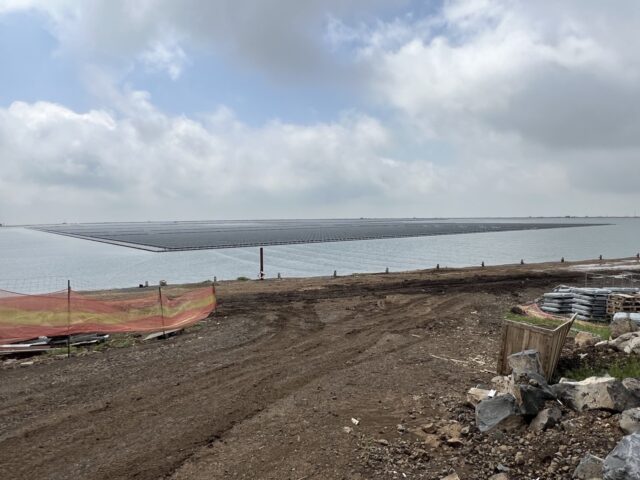
The Choshen (or “Breastplate”) reservoir, named after the Biblical adornment used by the High Priest to communicate with God, is covered with a floating solar array. Golan Heights, Israel, April 14, 2024 (Joel Pollak / Breitbart News)
The innovation of “dual use” reservoirs — providing water storage on the one hand, and “green” energy on the other — is just the latest advance pioneered by the Jewish National Fund (JNF), which manages Israel’s forests and farmland.
The JNF is responsible for some 250 of Israel’s 700 reservoirs. Unlike the massive reservoirs that comprise the state and federal water systems in California in the United States, Israel’s reservoirs are small-scale and more numerous.
California has not seen a major reservoir built since the late 1970s, but Israel built hundreds of small reservoirs from 1990 to 2010, after a water crisis in the 1970s and 1980s prompted the government to expand the system’s capacity.
Only some of the reservoirs are traditional flood reservoirs for storing rainwater. The two-year-old Choshen (or “Breastplate”) Reservoir, depicted above, stores pumped water from a local aquifer for timed release to local farms.
The Bar-On Reservoir, shown in the lead photo, is a more traditional flood reservoir, and works in tandem with another, older reservoir nearby. Engineers use pumps and locks to balance the water level between the two.
Many JNF reservoirs store treated wastewater, which accounts for some 90% of Israel’s agricultural supply, by far the most in the world. (The next-closest nation is Spain, which draws 40% of its supply from treated wastewater.)
Tal Golan, the chief engineer for the JNF, guided Breitbart News on a tour of the Golan, the territory taken by Israel from Syria during the Six Day War of 1967 and defended — at great a cost — during the Yom Kippur War of 1973.
Just hours before, Iran had launched a massive barrage of drones and missiles at Israel, which were intercepted by Israel’s air defenses and those of nearby allies. But the scene in the Golan was peaceful, as if nothing had happened.
Prior to 1967, Syria used the Golan to fire sporadically at Israeli towns and kibbutzim (collective farms) in the Galilee below. Syria also planned to divert the headwaters of the Jordan River, to deny Israel access to a fresh water supply.
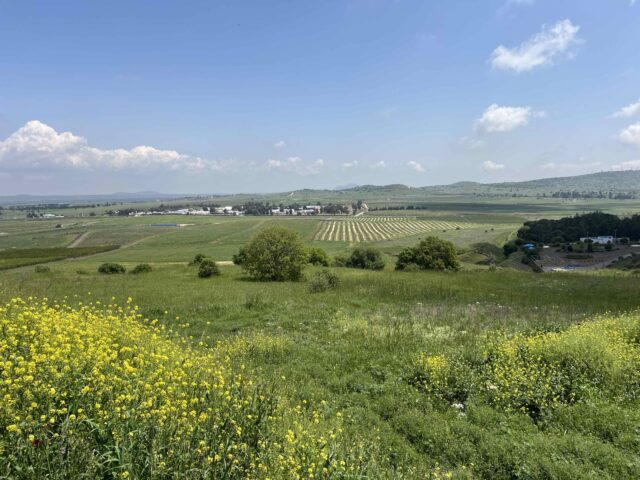
The Israeli-Syrian border, as seen from the northern Golan, near Quneitra and the Vale of Tears, looking east, April 14, 2024 (Joel Pollak / Breitbart News)
There was once talk of giving some or all of the Golan back to Syria in exchange for peace, much as Israel had done with the Sinai desert and Egypt in the Camp David Accords of 1978. But the Syrian regime refused to negotiate, and the near-collapse of the Syrian state in the wake of the Arab Spring of 2011 — with the so-called “Islamic State” filling some of the vacuum — ended any prospect of Israel ceding the Golan, which it had formally annexed in 1982.
Today, the Golan is a pastoral landscape of small towns, farms, kibbutzim, and wineries — and renewable energy projects, including wind farms. Winter rains leave the countryside lush and green — and fill the reservoirs.
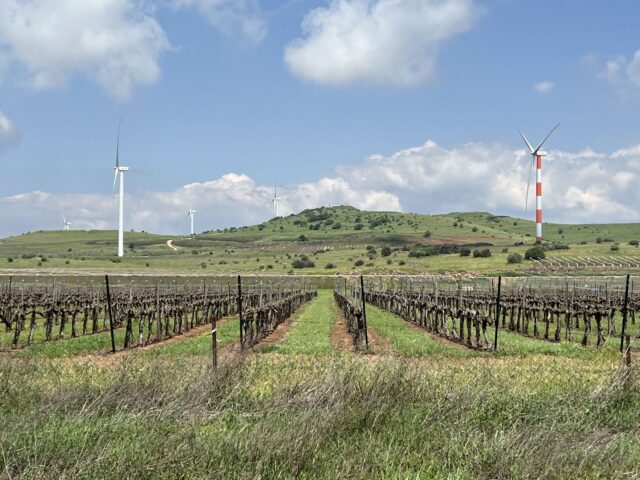
A vineyard in the Golan Heights, Israel, with wind turbines in the background. April 14, 2024 (Joel Pollak / Breitbart News)
Five of the Golan’s reservoirs use solar arrays, which are capable of generating 20 to 40 megawatts of electricity. The pontoons on which the solar panels sit are stacked near the reservoir; they can be added or removed to the array.
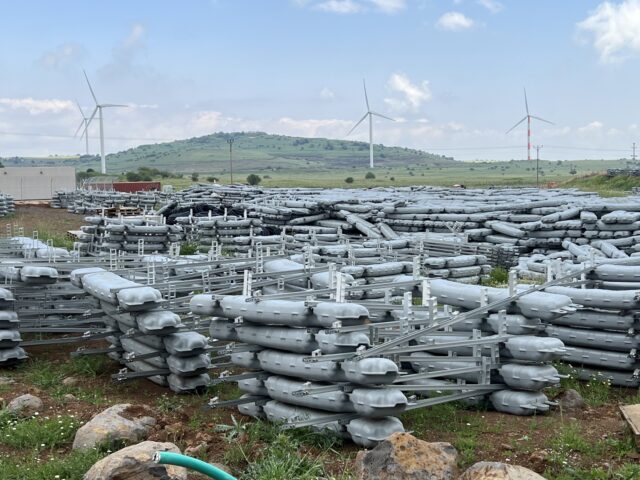
Pontoons for the floatation of solar panels at the Bar-On Reservoir, Golan Heights, Israel, April 14, 2024 (Joel Pollak / Breitbart News)
Engineers have had to wrestle with new challenges posed by the solar array, such as the effect of shade on the waters of the reservoir. They are also constantly engaged with other problems, such as the leaching of minerals into the soil of the banks and bottom of the reservoir. That is especially a problem with wastewater reservoirs, which engineers are trying to solve by using specialized sheets that interlock along the reservoir basin, and prevent almost all leakage.
There are prospects for exporting the dual use technology, especially as water and green energy form the basis for growing regional partnerships. The Prosperity Blue and Green agreements, signed by Israel, Jordan, and the United Arab Emirates (UAE), provide for solar energy to be produced in Jordan and sold to Israel in exchange for water from Israeli desalination plants. (The full implementation of those agreements has been delayed by the ongoing war.)
As California and the U.S. wrestle with a potentially drier climate in the near future — even after two very wet winters on the west coast — Israel’s small-reservoir design may offer an alternative to the larger projects of twentieth century.
In addition, the “dual use” technology that allows Israeli reservoirs to provide “green” energy as well as water could help American planners overcome the objections of environmental groups, who typically oppose reservoirs and dams.
Joel B. Pollak is Senior Editor-at-Large at Breitbart News and the host of Breitbart News Sunday on Sirius XM Patriot on Sunday evenings from 7 p.m. to 10 p.m. ET (4 p.m. to 7 p.m. PT). He is the author of the recent e-book, “The Zionist Conspiracy (and how to join it),” now available on Audible. He is also the author of the e-book, Neither Free nor Fair: The 2020 U.S. Presidential Election. He is a winner of the 2018 Robert Novak Journalism Alumni Fellowship. Follow him on Twitter at @joelpollak.
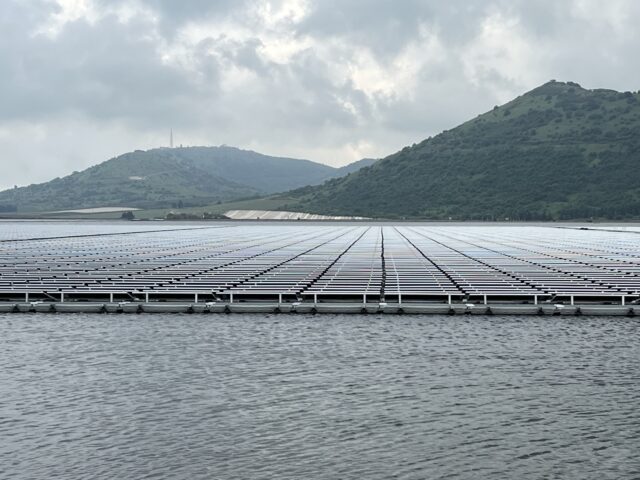
COMMENTS
Please let us know if you're having issues with commenting.